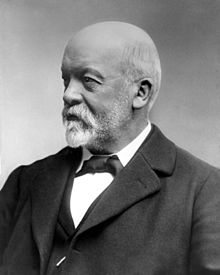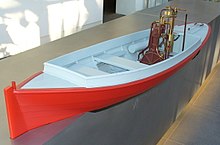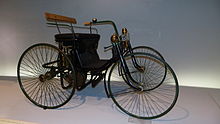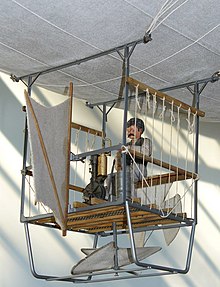Gottlieb Daimler
Gottlieb Wilhelm Daimler (actually Däumler ; born March 17, 1834 in Schorndorf ; † March 6, 1900 in Cannstatt near Stuttgart ) was a German engineer , designer and industrialist . Together with Wilhelm Maybach, Daimler developed the first high-speed gasoline engine and the first four-wheeled vehicle with a combustion engine .
life and work

Daimler was born on March 17, 1834 in Schorndorf as the second son of the innkeeper and master baker Johannes Friedrich Däumler (1801–1875) and his wife Wilhelmine Frederika, a born window maker (1803–1864). A museum has now been set up in the birthplace; In addition, a memorial at the Schorndorf town hall commemorates the city's most famous son.
After completing secondary school in 1848, Daimler trained as a gunsmith . In 1852 he finished his training with the journeyman's examination . In 1853 he began to work in a mechanical engineering company in Graffenstaden, Alsace, through the mediation of the Württemberg economic promoter Ferdinand von Steinbeis . In 1857 he left the company and began studying mechanical engineering at the Polytechnic School in Stuttgart. Here he became a member of the student union Corps Stauffia Stuttgart .
After completing his studies and several study trips abroad initiated by Steinbeis, he began to work as a designer for the Straub metal goods factory in Geislingen an der Steige in 1862 . In 1865 he was given the management of the Bruderhaus machine factory founded by Gustav Werner in Reutlingen , where he met Wilhelm Maybach for the first time . In 1867 Daimler married the pharmacist's daughter Emma Pauline Kurtz, with whom he had five children: Paul (* 1869), Adolf (* 1871), Emma (* 1873), Martha (* 1878) and Wilhelm (* 1881).
In 1869 Daimler took over the management of the workshops of the Karlsruhe mechanical engineering company . A short time later, Maybach also started working as a technical draftsman in the company. After three years, Daimler moved from the mechanical engineering company to the Deutz gas engine factory , where Nikolaus Otto made him head of the workshops. Maybach also switched to Deutz and in 1872, under the direction of Daimler, brought a four-stroke engine developed by Otto to series production. In 1875, Daimler registered a patent for an improved gas engine in the USA. The company grew from a small workshop to a global company.
After a dispute between Daimler and Otto, Daimler left Deutz AG in 1882 and founded a test workshop in Cannstatt. His goal was to develop small, fast-running internal combustion engines that could be used anywhere and drive vehicles of all kinds on land and on water. After a year (1883) he registered a revolutionary improved single-cylinder four-stroke engine developed together with Maybach, who was employed by him (see Figure No. 2: The first Daimler engine, 1883).
Unlike the stationary, gas- powered four-stroke engines that were common up to that time , this engine ran on gasoline ; the liquid gasoline was vaporized in a float carburetor and mixed with air. The glow tube ignition initiated the combustion of the mixture compressed in the cylinder. The single-cylinder engine weighed only 60 kilograms, had a displacement of 264 cm³ and developed around 1 hp (735 W) at 650 revolutions per minute. The rated speed was higher than that of the gas engines known up to then and therefore the engine performed relatively well for its size. The gasoline could be carried in a tank so that the engine was mobile and could also drive vehicles. On April 3, 1885, Daimler received the Imperial Patent No. 34926 for its power machine, which went down in technical history as a grandfather clock .
Another invention by Daimler and Maybach was the riding car constructed in 1885 , the first motorcycle with a gasoline engine (½ hp). This was followed by the installation of the gasoline engine in a boat six meters in length. In October 1886, Daimler and Maybach installed the grandfather clock motor in a carriage made by Wilhelm Wimpff . The still rumored opinion, the Vienna-Mecklenburg Siegfried Marcus was Carl Benz (three-wheeled Benz Patent Motor Car Number 1 , 1885) and Daimler anticipated in 1875, is incorrect. In 1887 Daimler built an engine into an exhibition tram . Not long after that, Daimler built a truck and a trolley with a two-cylinder V-engine (1888).
In order to be able to sell the developed engines, Daimler had a motor vehicle designed by Maybach between 1886 and 1889 , which celebrated its premiere at the Paris World Exhibition in 1889 . Under the name "Motor-Quadricycle" - also known as a steel wheel car - Daimler and Maybach developed a completely independent vehicle for the first time with an output of 1.5 hp and a speed of 18 km / h. Bicycle manufacturer NSU built the tubular frame .
In 1887 Daimler founded a factory in Cannstatt and in 1888 equipped the gondola of a gas balloon with its motor. This is how one of the first airships was created . On August 10, 1888, Michael, the long-time companion of Friedrich Hermann Wölfert , started from Daimler's factory on the Seelberg in Cannstatt on a trip to Aldingen .
At the 13th German Fire Brigade Day (July 28-30, 1888) in Hanover, he presented the world's first motorized fire engine . With its two-cylinder engine, it has 4 HP. On July 29, 1888, he received the patent under number 46779 from the Imperial Patent Office for a “motor-driven fire engine” .
In 1890 the company ran into trouble because it could not sell enough vehicles. To reorganize the company, Daimler founded the Daimler-Motoren-Gesellschaft , in which the industrialists Max Duttenhofer and Wilhelm Lorenz were involved alongside him and Wilhelm Maybach . Because of disputes with Lorenz, Daimler left the company in 1893. In the meantime, he and Maybach had developed the first two-cylinder in-line engine in 1892.
After the death of his first wife Emma in 1889, he married the widow Lina Hartmann, née Schwend, (1855–1932) with whom he had two children, Gottlieb (1894–1916) and Emilie (1897–1973).
With the support of the British industrialist Frederick R. Simms , who only wanted to acquire the rights to the Phönix engine when Daimler returned to Daimler-Motoren-Gesellschaft, Daimler became a shareholder again in 1894/95 and finally chairman of the supervisory board . In 1899 he had Maybach build a racing car that was baptized Mercedes (after the first name of the daughter of the Austrian businessman and consul general Emil Jellinek ).
Gottlieb Daimler died on March 6, 1900 in Cannstatt and was buried there in the Uff churchyard . He left about a quarter of the share capital of Daimler-Motoren-Gesellschaft to his family. Daimler had embezzled license fees from France and Duttenhofer obtained a waiver of all leadership claims from the family with the threat of a scandal. Shortly afterwards, a capital increase was decided, through which the Daimler family was pushed back into the role of a small shareholder of the Daimler-Motoren-Gesellschaft and no longer had any influence on its further development. In 1926 the Daimler-Motoren-Gesellschaft with the company Benz & Cie. merged by Carl Benz to form Daimler-Benz AG.
Brand name Daimler
The brand name Mercedes did not serve last to legal difficulties with the name Daimler To work abroad because other companies there had acquired the license to the Daimler engines and so driven vehicles. So the confusing situation arose that the company Ford held the rights to the brand name Daimler through the Daimler Motor Company , but sold it on March 26, 2008 to the Indian group Tata . According to WAZ, Tata is considering reactivating the Daimler brand.
As part of the renaming of DaimlerChrysler AG to Daimler AG on 4 October 2007, the Daimler board chairman gave Dieter Zetsche announced that the Group of Ford Motor Company 20 million US dollars (14 million euros) for the company Daimler has paid. The agreement states that Daimler AG may only use the name as a trade name or company name; no naming rights have been permanently transferred.
In Great Britain luxury sedans of the Daimler brand were produced until 2009 , from 1960 mostly as variants of Jaguar types, such as Daimler 250 V8 or Daimler Double Six . Until the end of the 1960s, the Daimler brand was preferred by the British royal family. When the British Queen drove up in a luxury car with a short, sloping trunk, it was mostly a Daimler limousine , not - as one might assume - a Rolls-Royce or Bentley .
Daimler as namesake
The largest stadium in Stuttgart was named after Gottlieb Daimler in 1993 as part of the World Athletics Championships. It only had this name until the start of training for the 2008/2009 football season. Since September 2008 it has been called the Mercedes-Benz Arena . Daimler has given its name to Mount Daimler , a 1280 m high mountain in the Antarctic, since 1964 .
literature
- Renate Völker, Karl-Otto Völker: Gottlieb Daimler - An eventful life. Silberburg-Verlag, Tübingen and Baden-Baden 2013, ISBN 978-3-8425-1230-6 .
- Harry Niemann: Gottlieb Daimler. Factories, banks and engines. Delius Klasing, Bielefeld 2000, ISBN 3-7688-1210-3 .
- Friedrich Schildberger: Daimler, Gottlieb Wilhelm. In: New German Biography (NDB). Volume 3, Duncker & Humblot, Berlin 1957, ISBN 3-428-00184-2 , pp. 485-487 ( digitized version ).
- Paul Siebertz: Gottlieb Daimler: a technology revolutionary. 4th edition, Stuttgart, Reclam-Verlag, 1950
- Paul Siebertz: Gottlieb Daimler in memory of a collection of documents. Stuttgart-Untertürkheim 1950 / Karl Benz and his life's work. Documents and reports. Published by Daimler-Benz Aktiengesellschaft. Stuttgart-Untertürkheim 1953.
- Hans-Christoph von Seherr-Thoss (Ed.): Two men, one star - Gottlieb Daimler and Karl Benz in pictures, data, documents. VDI-Verlag, Düsseldorf 1989, ISBN 3-18-400851-7 . These are reprints of the two above. Works in one volume.
Web links
- Literature by and about Gottlieb Daimler in the catalog of the German National Library
- Newspaper article about Gottlieb Daimler in the 20th century press kit of the ZBW - Leibniz Information Center for Economics .
- Susanne Eckelmann: Gottlieb Daimler. Tabular curriculum vitae in the LeMO ( DHM and HdG )
- Biography of Gottlieb Daimler in the weblog Text42
- Daimler at pro Alt Cannstatt ( Memento from August 18, 2007 in the Internet Archive )
- Daimler - Britains oldest Automobile Marqué
- Daimler and Benz Foundation
- Luftschiff - Boot - Reitwagen from Cannstatt ( Memento from June 9, 2004 in the Internet Archive )
- Automotive pioneers
- The tinkerer in the glass house In: The time.
Individual evidence
- ↑ youtube.com Daimler AG on Youtube.
- ^ Daimler, Gottlieb in the German biography
- ↑ a b Manfred Gihl: In the service of the fire department: Gottlieb Daimler, Carl Benz and Ferdinand Porsche . 1st edition. Sutton Verlag, Erfurt 2013, ISBN 978-3-95400-133-0 , p. 10 .
- ^ Christian Löer: Horch, Bugatti & Co: Cologne as the cradle of automobile construction . In: Kölner Stadt-Anzeiger . ( ksta.de [accessed on July 31, 2018]).
- ↑ GW Daimler - Improved Air and Gas Engine , US Patent No. 168623 issued October 11, 1875, United States Patent and Trademark Office.
- ↑ a b c d Plate on the occasion of the 30th anniversary of Gottlieb Daimler's death , in the “Allgemeine Automobil-Zeitung” of March 15, 1930, ÖNB.
- ↑ a b Figure 207: Daimler ship and Figure 208: Cannstätter Trambahn , in the newspaper “Le Chauffeur” of September 11, 1901, Bibliothèque nationale de France (French).
- ↑ Draisine and two-cylinder V-engine in "Gottlieb Daimler und seine Werk" , in the newspaper "Le Chauffeur" of September 25, 1901, Bibliothèque nationale de France (French).
- ↑ https://mercedes-benz-publicarchive.com/marsClassic/de/instance/ko/Daimler-Stahlradwagen-1889.xhtml?oid=5921
- ↑ Manfred Gihl: In the service of the fire department: Gottlieb Daimler, Carl Benz and Ferdinand Porsche . 1st edition. Sutton Verlag, Erfurt 2013, ISBN 978-3-95400-133-0 , p. 23 .
- ↑ Lina Hartmann Schwend Daimler at www.findagrave.com (English)
- ↑ boerse.ARD.de: Tschüss, Chrysler ( Memento of October 12, 2008 in the Internet Archive ).
- ^ Garbage Collector ( Memento of November 17, 2007 in the Internet Archive ).
- ↑ Welt.de: Not a Mercedes but a Daimler for the Queen
| personal data | |
|---|---|
| SURNAME | Daimler, Gottlieb |
| ALTERNATIVE NAMES | Daimler, Gottlieb Wilhelm (full name); Däumler, Gottlieb Wilhelm |
| BRIEF DESCRIPTION | German engineer, designer and industrialist |
| DATE OF BIRTH | March 17, 1834 |
| PLACE OF BIRTH | Schorndorf , Württemberg |
| DATE OF DEATH | March 6, 1900 |
| Place of death | Cannstatt , Württemberg |









